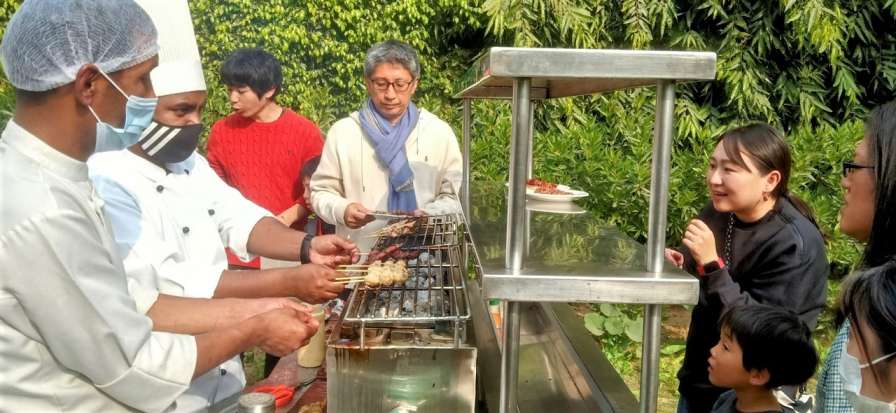Japanese families enjoy traditional rice pounding MochiTsuki (餅つき) festival, Japanese food as part of New Year celebrations
Besides elaborate Japanese cuisines, Yakitori on charcoal was an added attraction during the MochiTsuki festival where children too tried their hands.
GURUGRAM: A whole lot of Japanese families along with their children and women enjoyed an elaborate mix of Japanese delicacies on Friday in Gurugram during the Japanese rice-pounding festival MochiTsuki (餅つき) at Dia Park Premier Hotel.
The main attraction of the Japanese delicacies prepared by the team of chefs led by Japanese chef Shinji Nakajima was Yakitori (焼き鳥) on charcoal. It was introduced to the Japanese community for the first time here. There was a long queue of Japanese people enjoying Yakitori on charcoal with its aroma all around floating in the air under the open sky in the hotel’s lush green lawns.
Yakitori, also known as Kushiyaki, is a Japanese type of skewered chicken. Its preparation involves skewering the meat with kushi (串), a type of skewer typically made of steel, bamboo, or similar materials. Afterwards, they are grilled over a charcoal fire. During or after cooking, the meat is typically seasoned with tare sauce or salt.
The children in particular enjoyed the Mochi rice ponding practice as they tried their hands with the help of their parents and hotel chefs.

According to Narinder S Punihani, the promoter of Dia Park Premier Hotel, the MochiTsuki festival will be organised every year here. “From next year, we would have a more elaborate arrangement and added attractions for the Japanese guests. MochiTsuki festival will become an annual affair to bring the Japanese community closer to their traditional culture,” he added.
“We have introduced Yakitori on charcoal to give the Japanese the authentic Japanese cuisine experience. Generally, Yakitori is made on electric grills, not on charcoal, and thus it loses the very taste of this chicken delicacy. We don’t want to compromise on the originality of Japanese hospitality,” said Narinder S Punihani, who is prominently in the leather exports business for decades.
 Keiji Nakajima, Senior Advisor to Dia Park Premier Hotel, and a respectable figure in the Japanese community in India where he has been staying for the last 24 years said, “MochiTsuki festival was organised for the Japanese who didn’t go back to Japan or to other countries on the occasion of New Year celebrations, and stayed back here in India. The idea was to give them support to enjoy eating mochi. It’s not available in new Delhi otherwise, and we made it for them and served to make them enjoy in India.”
Keiji Nakajima, Senior Advisor to Dia Park Premier Hotel, and a respectable figure in the Japanese community in India where he has been staying for the last 24 years said, “MochiTsuki festival was organised for the Japanese who didn’t go back to Japan or to other countries on the occasion of New Year celebrations, and stayed back here in India. The idea was to give them support to enjoy eating mochi. It’s not available in new Delhi otherwise, and we made it for them and served to make them enjoy in India.”
Nakajima, who is Chairman, of Nakajima Consultancy Services LLP, and former CMD, of Sumitomo India, said though mochi rice was made many times during the year in Japan, during the New Year celebration, we make special mochi at the hotel. “I want to make others happier, and joyful. That’s the only reason I am supporting this hotel.”
 MochiTsuki festival is the centuries-old method of first steaming the sweet rice over an open fire, then placing the cooked rice into a warm stone or concrete bowl called an usu. Using large wooden mallets, two people rhythmically pound the rice in the usu, while with bare hands a third person swiftly moves the rice between each mallet crash.
MochiTsuki festival is the centuries-old method of first steaming the sweet rice over an open fire, then placing the cooked rice into a warm stone or concrete bowl called an usu. Using large wooden mallets, two people rhythmically pound the rice in the usu, while with bare hands a third person swiftly moves the rice between each mallet crash.
After several minutes of vigorous pounding, the rice becomes a thick, smooth dough – mochi. From manual pounding in the usu or special mochi-making appliances, the mochi is removed and children of all ages hand form the steaming-hot mochi into small handball-sized cakes, filling some of them with a sweet bean paste called ahn.



